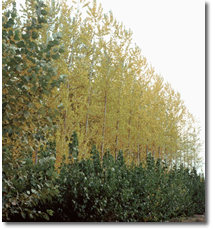Hybrids are usually more widely tolerant of environmental extremes than the parent trees.
 Commercial Uses
Commercial Uses
Buyers and prices for hybrid poplar chips are increasing as paper companies look for alternate sources to chip supply.|
|
What is a Hybrid Poplar? |
| Poplar is the general term for trees in the genus Populus. They include cottonwoods (poplars) and aspens. Most species are native to the temperate and colder areas of the northern hemisphere. Hybrids are created when plants of different species (usually in the same genus) are cross fertilized. This can occur naturally in areas where two crossable species overlap. We develop hybrids through our plant breeding. | |

